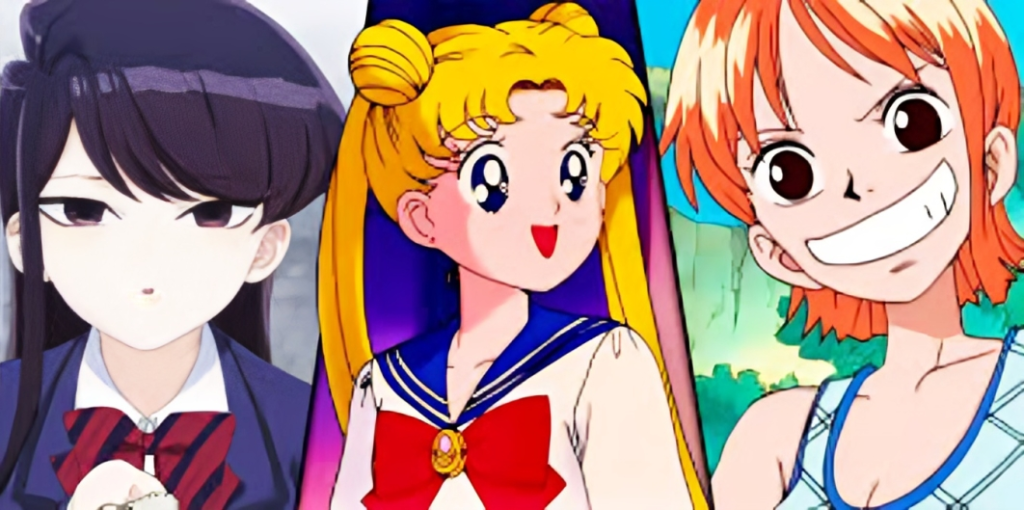Anime, a distinctive style of animation that originated in Japan, has become a global phenomenon. One of the most iconic and beloved aspects of anime is its portrayal of female characters, often referred to as “anime girls.” These characters are not only central to the narratives but also serve as cultural icons, influencing fashion, behavior, and even societal norms. This article delves into the multifaceted world of anime girls, exploring their evolution, characteristics, cultural impact, and the diverse roles they play in anime series and films.
Evolution of Anime Girls

Early Beginnings
The portrayal of female characters in Japanese animation can be traced back to the early 20th century. The 1960s saw the rise of “magical girl” series such as “Sally the Witch” (1966), which set the groundwork for future female protagonists. These early characters were often idealized, embodying traditional femininity and serving as role models for young girls.
The 1970s and 1980s: Diversification and Complexity
During the 1970s and 1980s, anime began to diversify, and so did the portrayal of female characters. The introduction of genres such as mecha, fantasy, and sci-fi brought forth a wider range of roles for anime girls. Series like “Cutie Honey” (1973) and “Nausicaä of the Valley of the Wind” (1984) featured strong, independent heroines who broke away from traditional gender roles.
The 1990s: Mainstream Popularity
The 1990s marked a significant turning point for anime girls as anime gained mainstream popularity both in Japan and internationally. Iconic series such as “Sailor Moon” (1992) and “Neon Genesis Evangelion” (1995) showcased female characters with complex personalities and compelling story arcs. This era also saw the rise of the “moe” phenomenon, characterized by cute and endearing female characters that evoked strong emotional responses from viewers.
The 2000s to Present: A Global Influence
In the 2000s and beyond, anime girls continued to evolve, reflecting changing societal norms and cultural trends. The globalization of anime led to the creation of diverse and multifaceted female characters that resonated with audiences worldwide. Today, anime girls come in all shapes, sizes, and personalities, representing a broad spectrum of experiences and backgrounds.
Characteristics of Anime Girls
Visual Aesthetics
Anime girls are often distinguished by their unique visual aesthetics, which include large, expressive eyes, colorful hair, and exaggerated facial expressions. These features are not only visually appealing but also serve to convey a wide range of emotions and personality traits.
- Eyes: The large eyes of anime girls are a signature feature, designed to express emotions more vividly. The shape, size, and color of the eyes can vary greatly, contributing to the individuality of each character.
- Hair: Anime girls often sport a variety of hairstyles and colors, ranging from natural shades to vibrant, unconventional hues. This diversity in hair design allows for greater creativity and helps to distinguish characters from one another.
- Clothing: The outfits worn by anime girls are often elaborate and stylized, reflecting the character’s personality, role, and the genre of the anime. From school uniforms and magical costumes to futuristic armor and traditional kimonos, the clothing is an integral part of the character’s identity.
Personality Traits
Anime girls are characterized by a wide range of personality traits, making them relatable and memorable to viewers. Some common archetypes include:
- Tsundere: A character who is initially cold or hostile but gradually reveals a warmer, more affectionate side. Examples include Asuka Langley Soryu from “Neon Genesis Evangelion” and Taiga Aisaka from “Toradora!”
- Yandere: A character who appears sweet and loving but becomes dangerously obsessive and possessive. Examples include Yuno Gasai from “Future Diary” and Kotonoha Katsura from “School Days.”
- Kuudere: A character who is calm, composed, and unemotional on the outside but has a hidden soft side. Examples include Rei Ayanami from “Neon Genesis Evangelion” and Kanade Tachibana from “Angel Beats!”
- Dandere: A character who is shy, quiet, and socially awkward but opens up to those they trust. Examples include Hinata Hyuga from “Naruto” and Mio Akiyama from “K-On!”
- Genki Girl: A character who is energetic, cheerful, and full of enthusiasm. Examples include Haruhi Suzumiya from “The Melancholy of Haruhi Suzumiya” and Yui Hirasawa from “K-On!”
Role in Storytelling
Anime girls play a crucial role in storytelling, serving as protagonists, antagonists, love interests, and supporting characters. Their actions, decisions, and growth often drive the narrative forward and create emotional connections with the audience.
- Protagonists: Female protagonists are central to many anime series, leading the story with their courage, determination, and resilience. Examples include Usagi Tsukino from “Sailor Moon” and Mikasa Ackerman from “Attack on Titan.”
- Antagonists: Female antagonists add depth and complexity to the story, challenging the protagonists and presenting moral dilemmas. Examples include Esdeath from “Akame ga Kill!” and Ragyo Kiryuin from “Kill la Kill.”
- Love Interests: Romantic relationships are a common theme in anime, and female characters often serve as love interests, adding emotional depth and tension to the plot. Examples include Inoue Orihime from “Bleach” and Hinata Hyuga from “Naruto.”
- Supporting Characters: Female supporting characters provide crucial assistance, guidance, and companionship to the protagonists. Examples include Winry Rockbell from “Fullmetal Alchemist” and Sasha Blouse from “Attack on Titan.”
Cultural Impact
Fashion and Style
Anime girls have had a significant influence on fashion and style, inspiring trends in clothing, hairstyles, and accessories. Cosplay, the practice of dressing up as anime characters, has become a global phenomenon, with fans meticulously recreating the outfits and appearances of their favorite characters. This has led to the proliferation of anime conventions, where fans gather to celebrate their shared passion for anime and showcase their cosplay creations.
Merchandise and Media
The popularity of anime girls has led to the creation of a vast array of merchandise, including figurines, posters, clothing, and accessories. These products not only serve as collectibles but also allow fans to express their love for their favorite characters. Additionally, anime girls often appear in various forms of media, such as video games, manga, and light novels, further expanding their reach and influence.
Representation and Diversity
Anime girls have played a significant role in promoting representation and diversity in media. While early portrayals often adhered to traditional gender roles and stereotypes, modern anime has seen the rise of more diverse and complex female characters. These characters challenge societal norms, embrace their individuality, and serve as role models for viewers.
- LGBTQ+ Representation: Anime has made strides in representing LGBTQ+ characters and relationships, with anime girls often playing central roles. Examples include Haruka Tenoh and Michiru Kaioh from “Sailor Moon” and Yuu Koito and Touko Nanami from “Bloom Into You.”
- Strong Female Characters: Many anime series feature strong female characters who defy traditional gender roles and stereotypes. Examples include Motoko Kusanagi from “Ghost in the Shell” and Erza Scarlet from “Fairy Tail.”
- Cultural Representation: Anime girls often reflect diverse cultural backgrounds, showcasing different traditions, customs, and experiences. Examples include the culturally rich settings of “Spirited Away” and “My Neighbor Totoro.”
Influence on Western Media
The influence of anime girls extends beyond Japan, impacting Western media and pop culture. Many Western animated series and films have drawn inspiration from anime, incorporating similar visual styles and character archetypes. Additionally, the popularity of anime streaming services has made anime more accessible to international audiences, further spreading the influence of anime girls.
Iconic Anime Girls
Sailor Moon (Usagi Tsukino)
Usagi Tsukino, also known as Sailor Moon, is one of the most iconic anime girls of all time. As the protagonist of the “Sailor Moon” series, she embodies the qualities of bravery, compassion, and determination. Usagi’s journey from an ordinary schoolgirl to a powerful warrior who fights for love and justice has resonated with audiences worldwide.
Asuka Langley Soryu
Asuka Langley Soryu, a central character in “Neon Genesis Evangelion,” is known for her fiery personality and complex emotional depth. As a skilled Eva pilot, Asuka struggles with her insecurities and seeks validation through her abilities. Her character arc explores themes of identity, self-worth, and human connection.
Mikasa Ackerman
Mikasa Ackerman from “Attack on Titan” is a formidable warrior known for her strength, loyalty, and unwavering dedication to protecting her loved ones. As one of the series’ main characters, Mikasa’s backstory and development highlight themes of loss, survival, and the search for freedom.
Haruhi Suzumiya
Haruhi Suzumiya, the titular character of “The Melancholy of Haruhi Suzumiya,” is a dynamic and eccentric high school student with a god-like ability to alter reality. Her boundless energy and curiosity drive the series’ narrative, leading to a blend of comedic and supernatural adventures.
Motoko Kusanagi
Motoko Kusanagi, the protagonist of “Ghost in the Shell,” is a cybernetic operative known for her intelligence, strength, and philosophical musings. As a character who blurs the lines between human and machine, Motoko explores themes of identity, consciousness, and the nature of existence.
Controversies and Criticisms
Sexualization and Objectification
One of the major criticisms of anime girls is the frequent sexualization and objectification of female characters. Some anime series depict female characters in revealing outfits and suggestive poses, catering to the male gaze. This has sparked debates about the impact of such portrayals on viewers’ perceptions of women and the perpetuation of harmful stereotypes.
Gender Stereotypes
While anime has made progress in diversifying its portrayal of female characters, some series still rely on traditional gender stereotypes. Characters may be depicted as overly submissive, dependent, or solely focused on romantic relationships. These portrayals can reinforce outdated notions of gender roles and limit the complexity of female characters.
Representation of LGBTQ+ Characters
While there has been an increase in LGBTQ+ representation in anime, it is not without its challenges. Some portrayals are criticized for being tokenistic or reinforcing stereotypes. Additionally, certain series may present LGBTQ+ relationships in a way that is fetishized or sensationalized, rather than treating them with the same depth and respect as heterosexual relationships.
FAQs
1. What is the main focus of the article “Anime Girls: A Comprehensive Exploration”?
- The article explores the evolution, characteristics, cultural impact, and diverse roles of female characters in anime, often referred to as “anime girls.”
2. How have anime girls evolved over time?
- Early Beginnings: In the early 20th century, characters were idealized and traditional.
- 1970s and 1980s: Introduction of diverse roles in genres like mecha, fantasy, and sci-fi.
- 1990s: Mainstream popularity with complex personalities and story arcs.
- 2000s to Present: Reflect changing societal norms and have a global influence.
3. What are some distinctive visual features of anime girls?
- Eyes: Large and expressive to convey emotions.
- Hair: Variety of styles and colors, both natural and unconventional.
- Clothing: Elaborate and stylized outfits that reflect their personality and role.
4. What are common personality archetypes of anime girls?
- Tsundere: Initially cold but becomes warm and affectionate.
- Yandere: Appears sweet but becomes obsessively possessive.
- Kuudere: Calm and unemotional outwardly but has a soft side.
- Dandere: Shy and quiet, opens up to trusted ones.
- Genki Girl: Energetic and cheerful.
5. What roles do anime girls play in storytelling?
- Protagonists: Lead the story with their courage and determination.
- Antagonists: Challenge protagonists and present moral dilemmas.
- Love Interests: Add emotional depth and tension.
- Supporting Characters: Provide assistance, guidance, and companionship.
Conclusion
Anime girls are a cornerstone of the anime medium, representing a rich tapestry of characters that reflect a wide range of human experiences and emotions. From their visual aesthetics and personality traits to their roles in storytelling and cultural impact, anime girls continue to captivate and inspire audiences around the world. While there are ongoing challenges and criticisms, the evolution of anime girls highlights the potential for greater diversity, representation, and complexity in media. As anime continues to grow and evolve, so too will the portrayal of these beloved characters, ensuring their enduring legacy in the world of animation.



